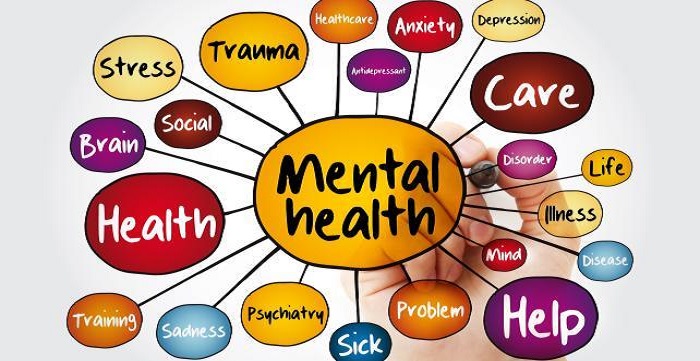Mental health encompasses our emotional, psychological, and social well-being. It influences how we think, feel, and act, playing a crucial role in managing stress, building relationships, and making choices.
Mental health is essential throughout all life stages, from childhood to adulthood. If you experience mental health issues, your thinking, mood, and behavior may be impacted.
Understanding Mental Health Conditions
Mental illnesses are disorders, ranging from mild to severe, that affect a person’s thoughts, mood, and behavior. According to the National Institute of Mental Health, nearly one in five adults lives with a mental illness.
Several factors contribute to mental health conditions, including:
- Biological factors, like genes or brain chemistry
- Life experiences, such as trauma or abuse
- Family history of mental health issues
Common mental health conditions include:
- Antisocial personality disorder
- Anxiety disorders (e.g., generalized anxiety, panic disorders, OCD, phobias, social anxiety)
- ADHD
- Bipolar disorder
- Borderline personality disorder
- Depression
- Eating disorders (anorexia, binge eating, bulimia)
- PTSD
- Schizophrenia
- Seasonal affective disorder
- Self-harm
- Suicidal behavior

A Serious Mental Illness (SMI) disrupts a person’s life and functioning. Misunderstandings about SMIs often portray them as personal failings, but they are not choices, weaknesses, or simply overcome by willpower.
Early Warning Signs & Symptoms
Are you or someone you know experiencing mental health concerns? Some early signs include:
- Overeating or lack of appetite
- Withdrawal from people and activities
- Persistent low energy
- Feeling numb or detached
- Unexplained physical pain
- Helplessness or hopelessness
- Increased smoking, drinking, or drug use
- Confusion, anger, worry, or fear
- Severe mood swings affecting relationships
- Persistent troubling thoughts or memories
- Hallucinations or delusions
- Thoughts of self-harm or harm to others
- Difficulty managing daily tasks
If you suspect someone has a mental health issue, talking about it can be challenging. Learning about common myths and ways to start a conversation may help.
Tips for Living Well with a Mental Health Condition
Managing a mental health condition can make it challenging to work, attend school, follow routines, and maintain relationships. However, with consistent treatment, including therapy and medication, it is possible to overcome these challenges.
New tools, evidence-based treatments, and social supports now help individuals achieve their goals. Some helpful strategies include:
- Sticking to a treatment plan and consulting a doctor before making changes
- Keeping your primary care physician updated for comprehensive care
- Learning about your condition to foster understanding
- Practicing self-care, including stress management, healthy eating, and exercise
- Reaching out to family and friends for support
- Developing healthy coping skills
- Prioritizing sleep, which affects brain function and mood
Mental health influences how people think, feel, and behave. Professionals help manage conditions like depression, anxiety, bipolar disorder, and addiction, which affect thoughts, feelings, and behaviors.
Good mental health enables individuals to enjoy life and build resilience. External factors, like relationships, also play a role in well-being. Stress, depression, and anxiety can disrupt daily routines, and many mental health issues have physical causes.
Defining Mental Health (WHO)
The World Health Organization states that mental health is “more than the absence of mental disorders.” True mental wellness includes managing active conditions, maintaining well-being, and pursuing happiness. The WHO emphasizes that individual, community, and societal efforts are crucial for mental health preservation.
In the U.S., the National Alliance on Mental Illness reports that nearly one in five adults experience mental health issues each year. In 2021, an estimated 14.1 million adults had a serious psychological condition.
Risk Factors for Mental Health Conditions
Mental health disorders can affect anyone, regardless of age, sex, income, or ethnicity. Depression is a leading cause of disability in the developed world.
Social circumstances, childhood experiences, biological factors, and health conditions shape mental well-being. Many individuals with mental health disorders have multiple conditions.
Mental well-being depends on a balance of factors that may influence disorder development, including:
- Socioeconomic Factors: Financial limitations and ethnic biases can increase disorder risks. A 2015 study in Iran highlighted poverty and urban fringe living as significant causes.
- Modifiable factors: Availability of work, social engagement, education, and housing quality.
- Nonmodifiable factors: Gender, age, ethnicity, and nationality. The study found that females with weaker economic status were more vulnerable to mental health issues.
- Childhood Adversity: Traumatic childhood experiences, such as abuse or parental loss, can increase the risk of mental and physical health issues and PTSD.
- Biological Factors: Family history can elevate mental health disorder risks due to certain genes. However, a genetic predisposition doesn’t guarantee a disorder, and those without a genetic link may also develop conditions. Physical health issues, like cancer or chronic pain, may contribute to stress and mental health problems.
Types of Mental Health Disorders
Healthcare professionals categorize mental health disorders based on their shared characteristics. These include:
- Anxiety disorders
- Mood disorders
- Schizophrenia disorders

Anxiety Disorders
Anxiety disorders are the most common type of mental health disorder, according to the Anxiety and Depression Association of America. People with these disorders experience intense fear or anxiety related to specific situations or objects. Most individuals with anxiety disorders try to avoid anything that triggers their anxiety.
Common anxiety disorders include:
- Generalized Anxiety Disorder (GAD): This disorder is characterized by excessive worry that interferes with daily activities. People with GAD may experience:
- Restlessness
- Fatigue
- Difficulty concentrating
- Muscle tension
- Sleep problems
Anxiety may not have a clear cause and can arise in everyday situations.
- Panic Disorder: People with panic disorder experience frequent panic attacks, which are sudden periods of intense fear or a sense of impending doom.
- Phobias: Phobias are intense fears of specific objects or situations. Common types include:
- Simple Phobias: Fear of specific objects or animals, like spiders.
- Social Phobia (Social Anxiety Disorder): A fear of being judged or watched by others, leading people to avoid social situations.
- Agoraphobia: A fear of situations where escape may be difficult, such as in crowded places or public transport.
- Obsessive-Compulsive Disorder (OCD): People with OCD experience intrusive, stressful thoughts (obsessions) and feel compelled to perform repetitive actions (compulsions), like washing hands repeatedly.
- Post-Traumatic Stress Disorder (PTSD): PTSD can develop after experiencing or witnessing a traumatic event, causing persistent feelings of fear or helplessness. Symptoms may include flashbacks and intense stress.
Mood Disorders
Mood disorders, also called affective disorders or depressive disorders, are characterized by significant changes in mood, including periods of mania (elevated mood) and depression. Common mood disorders include:
- Major Depression: Individuals with major depression experience constant feelings of sadness, loss of interest in daily activities, and a lack of energy. These feelings can interfere with normal functioning.
- Bipolar Disorder: Bipolar disorder is marked by extreme mood swings, ranging from manic phases of high energy to depressive episodes marked by low mood and fatigue.
- Seasonal Affective Disorder (SAD): This type of depression occurs during the fall and winter months when daylight hours are shorter. It is common in regions farther from the equator.
Schizophrenia Disorders
Schizophrenia is a spectrum of disorders involving psychosis, with symptoms that disrupt thoughts and perceptions. Signs typically emerge between the ages of 16 and 30. Symptoms of schizophrenia include both positive and negative symptoms:
- Positive symptoms: These include delusions, hallucinations, and disorganized thinking.
- Negative symptoms: These may involve a lack of motivation, emotional flatness, and withdrawal from social interactions.
Early Signs of Mental Health Disorders
There are no physical tests that can definitively diagnose mental health conditions, but certain behaviors and symptoms can signal the development of a disorder:
- Withdrawing from friends, family, or activities
- Changes in sleep or appetite
- Persistent feelings of hopelessness
- Low energy levels
- Increased use of alcohol, nicotine, or other substances
- Difficulty concentrating or thinking clearly
- Struggling with everyday tasks
- Recurring intrusive thoughts or memories
- Thoughts of harming oneself or others
- Hearing voices or experiencing delusions
Diagnosis
Diagnosing a mental health disorder involves multiple steps. A healthcare professional may start by reviewing the person’s medical history and performing a physical examination to rule out other conditions. They may also conduct laboratory tests, such as bloodwork or imaging exams, to check for underlying causes.
A psychological evaluation is also important. This involves asking about symptoms and their impact on daily life. Mental health questionnaires may be used to gain insight into thoughts, feelings, and behaviors.
Most mental health professionals rely on the Diagnostic and Statistical Manual of Mental Disorders, 5th edition (DSM-5-TR), which provides criteria and descriptions to assist in diagnosis.
Treatment
Treatment for mental health disorders is personalized, and what works for one person may not work for another. Several treatment options may be combined for effective management. A person’s doctor or mental health provider will help identify the most appropriate approach.
Psychotherapy (Talking Therapies)
Various types of psychotherapy are used to treat mental health disorders, including:
- Cognitive Behavioral Therapy (CBT)
- Exposure Therapy
- Dialectical Behavior Therapy (DBT)
These therapies help people understand their condition, manage daily life, and reduce the risk of isolation and self-harm. Mental health professionals such as psychiatrists, psychologists, and therapists provide these treatments. Medication
Medications may include antidepressants, antipsychotics, or anti-anxiety drugs. While medications do not cure mental health disorders, they can alleviate symptoms and help people manage social interactions and daily activities. Some medications help balance brain chemicals like serotonin. Self-Help and Lifestyle Changes
Some people make lifestyle changes to manage their mental health, such as:
- Reducing alcohol consumption
- Improving sleep habits
- Eating a balanced diet
- Practicing relaxation techniques like deep breathing and mindfulness
Having a support system, whether through self-help groups, family, or friends, is also beneficial.
By working closely with a healthcare provider, individuals can find treatment strategies that suit their needs and help them manage their condition effectively.

